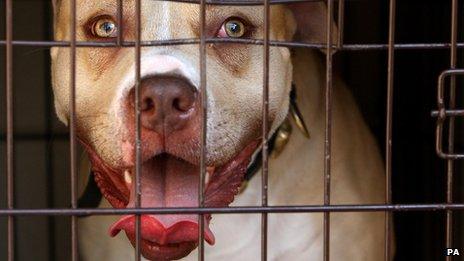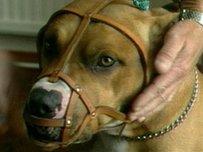Dangerous dog laws: A history
- Published

Ministers are planning laws to tackle dangerous dogs. It's a problem that's worried our leaders since Roman times:
Romans - Lex Pesolania

Dog laws existed in the days of Cicero, according to some historians
Dogs were a feature of Roman life, used as weapons of war and kept as pets. The ancient 'lex Pesolania' could be seen as a forerunner to the Dangerous Dogs Act - making owners culpable for the behaviour of their dog.
In the third century BC, unruly dogs were apparently such a problem that a law was passed that ensured owners were responsible for any injuries or damage the animal caused.
"If a dog was in a square or public road and not tied up in the daytime and did mischief the owner was liable," according to the late Liberal MP and Roman historian Henry John Roby.
First fines
A nineteenth century study of the British dog seems to suggest attacks on people have been a continuing cause for concern. According to George Jesse, dog-related fines were introduced under Alfred the Great.
The law, which could date as far back as 849 AD, said: "If a dog tear or bite a man, for the first misdeed let six shillings be paid." Fines increased for repeat offences.
1839 Metropolitan Police Act
<link> <caption>Under the act</caption> <url href="http://www.legislation.gov.uk/ukpga/1839/47/pdfs/ukpga_18390047_en.pdf" platform="highweb"/> </link> <bold>,</bold> Victorian Londoners could be fined up to 40 shillings if they let their dog loose "in any thoroughfare or public place".
Anyone with an "unmuzzled ferocious dog" that they allowed "to attack, worry, or put in fear any person, horse or other animal" was liable.
Dog owners in the rest of England faced the 40 shilling fine - or a new punishment of two weeks in prison - when the <link> <caption>Town Police Clauses Act of 1847</caption> <url href="http://www.legislation.gov.uk/ukpga/1847/89/pdfs/ukpga_18470089_en.pdf" platform="highweb"/> </link> extended the law to "every person... in any street" if their dog was deemed to be dangerous and not on a lead.
The first piece of legislation giving the authorities power to seize a dog was passed almost a quarter of a century later.
1871 Dogs Act
Described by the government as "an act to provide further protection against dogs", the <link> <caption>1871 Dogs Act</caption> <url href="http://www.legislation.gov.uk/ukpga/1871/56/pdfs/ukpga_18710056_en.pdf" platform="highweb"/> </link> gave a police chief the power to take a dog from its owner and either put it down or sell it.
But then as now, the law had its opponents.
The Lord Chancellor worried that an owner might still be liable even if they "had no previous knowledge of any mischievous propensity in the dog". What if a "playful dog, intending no mischief, might tear a man's trousers?" he asked peers.
And while the act is still widely used by the authorities against dog owners today, it does not - short of confiscation - allow the courts to punish the owners of dangerous dogs.
The government argue that because the act is not part of criminal law, the standard of proof is lower and - unlike the infamous 1991 Dangerous Dogs Act - it can be used to impose controls or confiscation of dangerous dogs where an offence has taken place on private property.
"It is particularly appropriate for action on behalf of people such as postmen and women who are regularly at risk from dogs in front gardens," according to the Department for Food and Rural Affairs.
1989 Dangerous Dogs Act
Until 1987 dog owners were required to buy a 37p 'dog licence'. But the licence was widely ignored and when the first Dangerous Dogs Act was introduced, ministers said they would not reintroduce it.
The 1989 act increased the 100-year-old powers available to the court - giving magistrates the power to disqualify perpetrators from owning a dog.
1991 Dangerous Dogs Act

The 1991 attack on Rucksana Khan sparked new dog laws
Twenty-one years ago this week, six-year-old Rucksana Khan was playing in a park near her home in Bradford when she was savaged by a pit bull terrier and taken to hospital with critical head and chest injuries.
The case - which followed 10 others in 1991 read out to Parliament by Bradford MP Bob Cryer - prompted the then home secretary to introduce a bill promising "to rid the country of the menace of these fighting dogs".
Four types of dog were <link> <caption>banned under the act</caption> <url href="http://www.legislation.gov.uk/ukpga/1991/65/pdfs/ukpga_19910065_en.pdf" platform="highweb"/> </link> , which makes it an offence for an owner to allow any dog "to be dangerously out of control".
But the legislation, which was rushed through following public outcry about the early 1990s attacks, has been criticised as not fit for purpose.
Critics say there are no breeds predisposed to violence and that the act does nothing to deal with the root cause of dog attacks - the owners.
"It's punitive rather than controlling," said Trevor Cooper, a solicitor who specialises in dog law. "It tries to weed out certain types of dog but you can't prejudge a dog's behaviour.
"It's down to the way the dog has been brought up. There's no point continuously punishing people without dealing with the actual cause."
Mr Cooper, a legal adviser to the Dogs Trust, said the system of dog control notices in place in Scotland and Northern Ireland should be extended to England and Wales. This would be far more effective in preventing dog attacks as it would give the council the power to order owners to leash or muzzle their dogs and to take training courses, he said.

Campaigners want more controls for dogs rather than bans on breeds like pit bulls
Another problem in England and Wales is that the act does not cover attacks on private property.
And in the last few years there have been a number of cases of babies, children and adults attacked and often killed in gardens and homes where, legally, the dog had every right to be.
There are an estimated 5,000 dog attacks on British Telecom, Royal Mail and Parcel Force staff in England every year. Postal workers union the CWU estimate that 70% of the attacks on their staff happen on private property - so would not have been covered by the act.
Dangerous Dogs (Amendment) Act 1997
Conservative Home Office minister Tom Sackville told MPs in early 1997 that the Dangerous Dogs Act had "achieved its main objectives". He said the law had reduced the number of pit bulls and raised dog ownership standards.
Rules were to be relaxed and courts were given more flexibility to decide whether a dangerous dog had to be put down.
Although there was a change of government with Labour winning the 1997 election, they passed into law the measures the Conservatives had earlier proposed.
Authorities were also given the power to impose controls on the offending dog - muzzling, leashing or neutering.
Dog Control Orders (2006)
Local authorities were given the power to issue orders to dog owners to control dog fouling, ensure dogs are kept on a lead and to keep them away from certain areas.
The idea was to replace local byelaws to protect children's playgrounds, beaches or picnic areas from unruly dogs and their mess.
Breach of a control order can attract a maximum fine of £1,000.
What next?
Dog attacks appear to be on the rise. The number of people convicted for dangerous dog offences rose almost 40% between 2009 and 2010.
And it's not just that the police might be giving the issue more attention. Dog-related hospital admissions have more than doubled from 2,915 in 1997 to 6,118 in 2010. In 2009 alone, dog attacks cost the NHS £3.3 million in treatment costs.
Ministers have suggested four measures in an attempt to tackle the problem:
Compulsory microchipping
Extending existing laws to cover private property
Increasing the fee owners have to pay if they want their dog exempt from the government list of prohibited types
Allow owners to hold on to their dogs until the outcome of court proceedings
Trevor Cooper of the Dogs Trust said: "The government has the chance to introduce legislation and and think of new ways to deal with a very old problem. This is a missed opportunity."